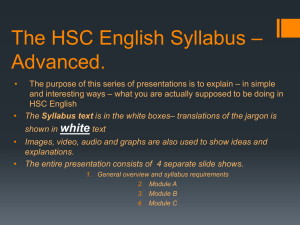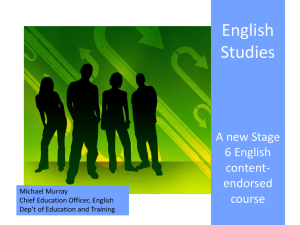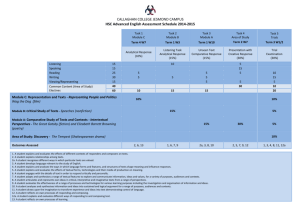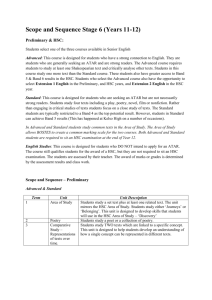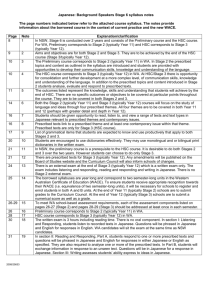English Standard Outline
advertisement
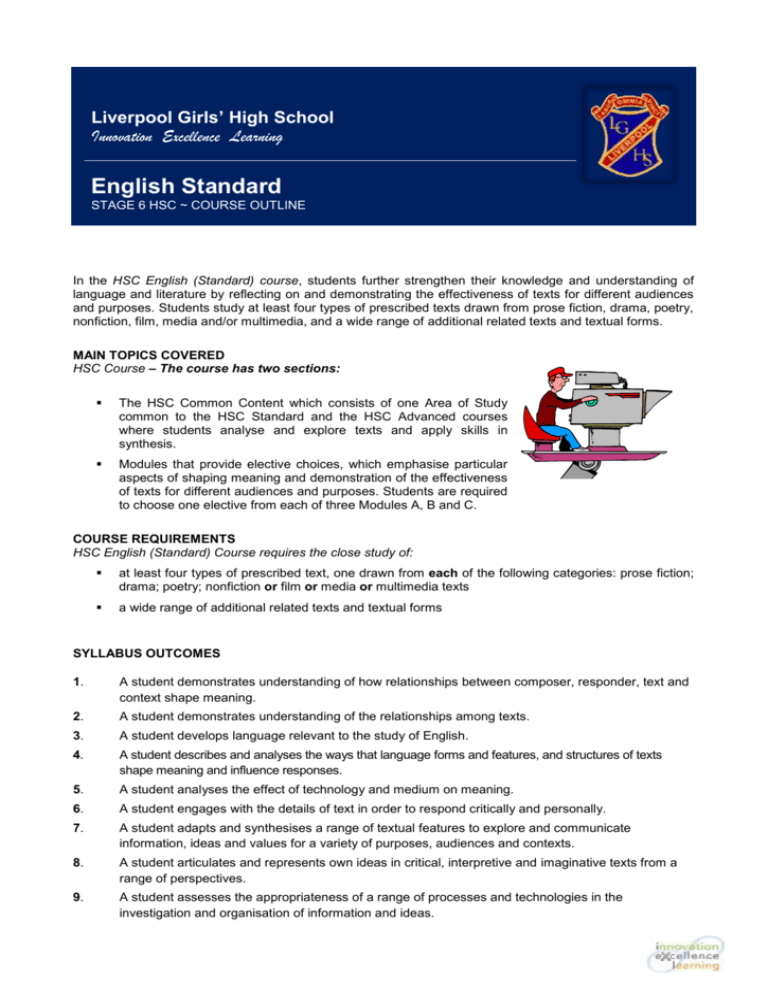
Liverpool Girls’ High School Innovation Excellence Learning English Standard STAGE 6 HSC ~ COURSE OUTLINE In the HSC English (Standard) course, students further strengthen their knowledge and understanding of language and literature by reflecting on and demonstrating the effectiveness of texts for different audiences and purposes. Students study at least four types of prescribed texts drawn from prose fiction, drama, poetry, nonfiction, film, media and/or multimedia, and a wide range of additional related texts and textual forms. MAIN TOPICS COVERED HSC Course – The course has two sections: The HSC Common Content which consists of one Area of Study common to the HSC Standard and the HSC Advanced courses where students analyse and explore texts and apply skills in synthesis. Modules that provide elective choices, which emphasise particular aspects of shaping meaning and demonstration of the effectiveness of texts for different audiences and purposes. Students are required to choose one elective from each of three Modules A, B and C. COURSE REQUIREMENTS HSC English (Standard) Course requires the close study of: at least four types of prescribed text, one drawn from each of the following categories: prose fiction; drama; poetry; nonfiction or film or media or multimedia texts a wide range of additional related texts and textual forms SYLLABUS OUTCOMES 1. A student demonstrates understanding of how relationships between composer, responder, text and context shape meaning. 2. A student demonstrates understanding of the relationships among texts. 3. A student develops language relevant to the study of English. 4. A student describes and analyses the ways that language forms and features, and structures of texts shape meaning and influence responses. 5. A student analyses the effect of technology and medium on meaning. 6. A student engages with the details of text in order to respond critically and personally. 7. A student adapts and synthesises a range of textual features to explore and communicate information, ideas and values for a variety of purposes, audiences and contexts. 8. A student articulates and represents own ideas in critical, interpretive and imaginative texts from a range of perspectives. 9. A student assesses the appropriateness of a range of processes and technologies in the investigation and organisation of information and ideas. 10. A student analyses and synthesises information and ideas into sustained and logical argument for a range of purposes and audiences. 11. A student draws upon the imagination to transform experience and ideas into text, demonstrating control of language. 12. A student reflects on own processes of responding and composing. 13. A student reflects on own processes of learning. BOSTES ASSESSMENT INFORMATION External examination Marks Paper 1 – Area of Study Section I Shortanswer questions 15 Section II Candidates compose or adapt a text 15 Section III Candidates answer one sustained response question 15 Paper 2 – Modules Section I Module A: Experience Through Language Candidates answer one sustained response question Section II Module B: Close Study of Text Candidates answer one sustained response question Paper 2 – Modules Section I Module A: Experience Through Language Candidates answer one sustained response question 20 20 20 TOTAL MARKS 105 Internal assessment Weighting Area of Study 40 Module A 20 Module B 20 Module C TOTAL 20 100 Modes to be assessed across the components Weighting Listening 15 Speaking Reading Writing Viewing/Representing 15 25 30 15 TOTAL MARKS 100 Task No. Targeted Outcomes Learning Context 1 H – 1, 8 AOS – Discovery 2 H – 6, 8 3 H – 6, 11 4 H – 4, 10 Experience Through Language – Module A Close Study of Text – Module B AOS, Module A, Module B Texts and Society – Module c 5 TOTAL H – 2, 5 Task Creative Response Oral Presentation Visual Representation and written response Trial HSC Examination Visual / Audio related Text response Date Due Weighting A T4 Wk 8 Tm 1 Wk 8 Tm 2 Wk 6 Tm 2 Wk 9 B C D 5% 15% E 20% 15% 15% 5% 15% 15% 15% 15% 25% 20% 25% 10% 20% 5% 15% Ma rks EVIDENCE OF LEARNING (Assessment) 30% 15% 100 %
